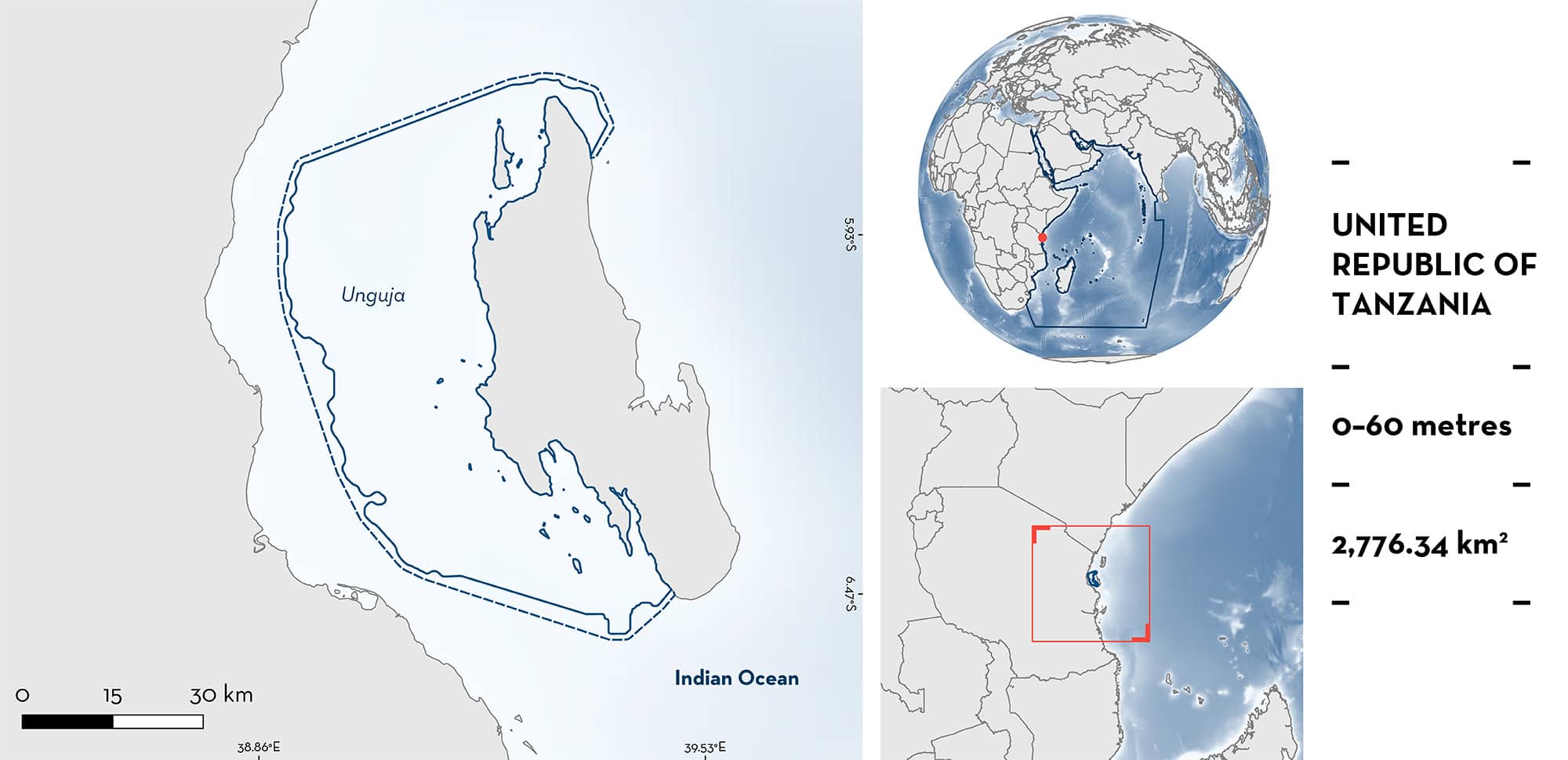ISRA FACTSHEETS
ISRA FACTSHEETS
WESTERN INDIAN OCEAN REGION
Unguja
Summary
Unguja is located in the Zanzibar Archipelago, Tanzania. The area is characterised by the presence of coral reefs, mangroves, and sandy substrates. The area overlaps with one Ecologically or Biologically Significant Marine Area, two Key Biodiversity Areas, and two protected areas. Within the area there are: threatened species (e.g., Bowmouth Guitarfish Rhina ancylostomus); range-restricted species (Zanzibar Guitarfish Acroteriobatus zanzibarensis); reproductive areas (e.g., Bluespotted Maskray Neotrygon caeruleopunctata); and the area sustains a high diversity of sharks (23 species).
Download factsheet
Unguja
DESCRIPTION OF HABITAT
Unguja is the main southern island in the Zanzibar Archipelago, Tanzania. It is separated from the mainland by ~40 km of shallow waters. The area is characterised by the presence of coral reefs, mangroves, and sandy substrates. Unguja is mainly influenced by the East African Coastal Current and monsoon winds. Southern monsoon winds (May–September) are stronger than northeast monsoon winds (November–March) and produce higher Chlorophyll-a concentrations (Peter et al. 2018). Mean sea surface temperature ranges from 23°C (austral winter) to 30°C (Limbu & Kyewalyanga 2015; Semba et al. 2016). Heavier rains occur in May, when the Wami and Ruvu Rivers have a higher discharge flowing to the area (Painter 2020).
The area overlaps with the Zanzibar (Unguja)–Saadani Ecologically or Biologically Significant Marine Area (EBSA; CBD 2023) and two Key Biodiversity Areas (KBA), Zanzibar Island-South Coast and Tumbatu Island (KBA 2023a, 2023b). In addition, it overlaps with the Menai Bay Conservation Area and Chumbe Island Coral Park.
This Important Shark and Ray Area is benthopelagic and is delineated from inshore and surface waters (0 m) to 60 m based on the bathymetry of the area and the distribution of the Qualifying Species.
CRITERION A
VULNERABILITY
Twenty-two Qualifying Species considered threatened with extinction according to the IUCN Red List of Threatened SpeciesTM regularly occur in the area. Threatened sharks comprise one Critically Endangered species, one Endangered species, and four Vulnerable species; threatened rays comprise two Critically Endangered species, 10 Endangered species, and four Vulnerable species (IUCN 2023).
CRITERION B
RANGE RESTRICTED
This area holds the regular presence of Zanzibar Guitarfish as a resident range-restricted species.
Zanzibar Guitarfish are regularly caught in local fisheries within the area year-round with 128 individuals landed between 2019–2023 (Wildlife Conservation Society unpubl. data 2023). While recorded at a mainland site, this species has not been reported from other islands (e.g., Pemba Island) despite regular landing site surveys. This species is endemic to the Somali Coastal Current Large Marine Ecosystem.
CRITERION C
SUB-CRITERION C1 – REPRODUCTIVE AREAS
Unguja is an important reproductive area for two ray species.
Between 2019–2023, 748 Bluespotted Maskray were recorded from the catch of artisanal fisheries in the area, of which 34 (4.5%) measured between 15–25 cm disc width (DW) (Wildlife Conservation Society unpubl. data 2023). Size-at-birth for the species is ~17 cm DW (Last et al. 2016) and size-at-one-year is ~25 cm DW according to age-and-growth studies (O’Shea et al. 2023). Therefore, these individuals were likely neonates or young-of-the-year. In comparison, artisanal landing data from Pemba Island during the same period indicate that 822 Bluespotted Maskrays were landed, of which only three (0.4%) measured < 25 cm DW. Furthermore, of the eight artisanal fisher landing sites monitored across mainland Tanzania during this same period, the Bluespotted Maskray was only recorded in Somanga landing site (199 individuals), with no individuals < 25 cm DW observed (Wildlife Conservation Society unpubl. data 2023). These findings suggest that Unguja sustains a large number of these smaller rays and is more important for this species than other sites in Tanzania.
Between 2019–2023, 37 Bowmouth Guitarfish measuring 52–240 cm TL were recorded from the catch of artisanal fisheries in the area (Wildlife Conservation Society unpubl. data 2023). Size-at-birth for the species is ~46 cm TL (Last et al. 2016) and size-at-one-year is ~73 cm TL according to age-and-growth studies (Kurniawan et al. 2021). Five individuals (13% of individuals recorded) were 52–54 cm TL and could be considered young-of-the-year. One landed female measuring 232 cm TL was likely pregnant due to her extended abdomen. In comparison, during the same period, 23 Bowmouth Guitarfish were observed at artisanal fisher landing sites in Pemba Island and mainland Tanzania, with none of these measuring < 73 cm TL (Wildlife Conservation Society unpubl. data 2023). Life history knowledge for this species is scarce (Kyne et al. 2019), so this evidence highlights the regional importance of Unguja as an important reproductive area for this species.
CRITERION D
SUB-CRITERION D2– DIVERSITY
Unguja sustains a high diversity of Qualifying Species (23 species). This exceeds the regional diversity threshold (22 species) for the Western Indian Ocean. These species have been observed regularly in landings from artisanal fisheries operating exclusively within the area (Schaeffer 2004; Barrowclift et al. 2017; Temple et al. 2019, 2020; Wildlife Conservation Society unpubl. data 2023).
Download factsheet
SUBMIT A REQUEST
ISRA SPATIAL LAYER REQUEST
To make a request to download the ISRA Layer in either a GIS compatible Shapefile (.shp) or Google Earth compatible Keyhole Markup Language Zipped file (.kmz) please complete the following form. We will review your request and send the download details to you. We will endeavor to send you the requested files as soon as we can. However, please note that this is not an automated process, and before requests are responded to, they undergo internal review and authorization. As such, requests normally take 5–10 working days to process.
Should you have questions about the data or process, please do not hesitate to contact us.


